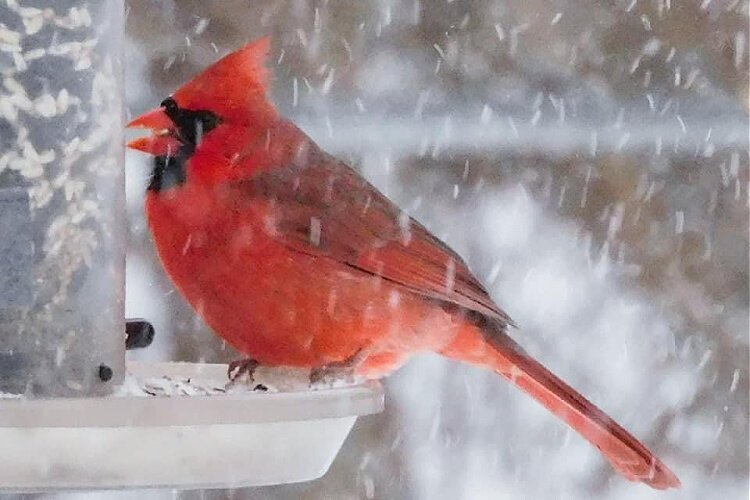It’s a scary time for birds
Plus, 12 ways to help keep our local birds a bit safer during the fall and winter.

According to the latest research, America’s birds are flying into oblivion in numbers that scientists call “staggering.” All told, the North American bird population is down by 2.9 billion breeding adults. Forests alone have lost 1 billion birds. Additionally, grassland bird populations have declined by over 50%, or another 720 million birds. That means that one in four birds has disappeared in the last 50 years. Those statistics should cause downright fright.
Endangered birds in backyards
In greater Cincinnati, there are over 20 species of endangered or threatened birds. The list includes multiple species of warblers, sparrows, woodpeckers, terns, cranes and even the rusty blackbird.
According to Brett Gilmore, owner of Wild Birds in Montgomery, one of the most striking on that list — the red-headed woodpecker — is among the year-round species you’re most likely to see in your yard around this time of year. Their vibrant crimson heads and graphic black-and-white bodies are a joy to see.
Thankfully, most of our year-round species are not in danger right now, and are listed as “birds of least concern,” meaning their populations are healthy. “The most common birds this time of year are the Cardinal, Blue Jay, Carolina Chickadee, Tufted Titmouse, American Goldfinch, Mourning Dove and six woodpecker species (Red-bellied, Downy, Hairy, Pileated, Red-headed and Northern Flicker) to name just a few. We also have non-native species such as House sparrows, European Starlings and city pigeons (Rock Dove),” says Brett.
Even common species are winging toward uncommon
Many of these are considered “common birds,” but some are unfortunately becoming uncommon. One is a favorite species seen at bird feeders mentioned by Brett, Dark-eyed Juncos, also known as snowbirds, which are down by 168 million according to research from the Cornell Lab.
Additionally, some other bird species visit the area during cold weather. “There are several species that overwinter in the Cincinnati area like the Dark-eyed Junco, White-throated Sparrow and other native sparrow species (White Crowned, Fox). In irruption years when food is scarce in the boreal forest, we can get Pine Siskins, Red-breasted Nuthatch, and Purple Finch which move south looking for food,” says Brett.
While they’re designed to weather local winters whether we feed them or not, “A well-stocked bird feeder and clean bird bath can be very helpful for our local native species that hang out year-round,” offers Cody Sowers, Head Aviculture Keeper at the Cincinnati Zoo & Botanical Gardens.
Need an assist on bird identification? Brett recommends the Merlin Bird ID app, which utilizes sound ID, step-by-step ID or photo ID to help you figure out which bird is which.
12 ways you can help local birds
While the reasons behind the severe population decline are sweeping and systemic, there are things humans can all do to help keep local birds a bit safer during the fall and winter — and all year round.
- Put your lights on a timer. Lights can disorient birds, particularly for nocturnal migrating species in late summer and early fall. Apply this practice to all your lights, including colored holiday lights, landscaping lights and porch lights. Schedule them to be turned off after dusk. If you work in an office building, make sure lights are turned off at night. “Lights and light pollution can have a huge effect on migratory birds,” says Cody.
- Skip synthetic spider webs. Yes, they look spooky, but they can trap birds’ wings, beaks and feet.
- Think natural décor. Pumpkins and pumpkin seeds are particularly appropriate for harvest season. You can soak carved pumpkins in vinegar if you want to preserve the hollowed out gourd as a feeder itself! Or just let the pumpkins decompose naturally, leaving the seeds out for bird food as well. Also, Cody advises against decorating with anything that looks like food. “Fake berries in fall or holiday wreaths come to mind,” he says.
- Make windows safer, day and night. Glass reflects elements of birds’ habitat, inviting them to fly right in. Windows in homes and offices kill up to 1 billion birds each year. Keep blinds half-open or closed when you’re not using the room, apply bird stickers or install a bird net a few inches in front of windows.
- Feed the birds. In the winter, opt for high-energy choices like suet, peanuts and sunflower chips. They’re also quick and easy for birds to eat, so they can feed efficiently on cold days. Consider ground or platform feeders for birds that don’t like to visit hanging feeders. And make sure to keep seed dry, and clean the feeders about once a week.
- Keep cats indoors. They’ll live longer and let birds live longer, too, since outdoor cats on the prowl kill more birds than any other non-native threat.
- Reduce lawn by planting native species. The U.S. has 63 million acres of lawn. Converting even a fraction of that offers a huge potential for supporting wildlife. “Planting for birds and butterflies is easy and recommended,” says Brett. “Coneflowers, zinnias, sunflowers, coreopsis and black-eyed Susans provide food and nectar to many summer species,” he advises.
- Leave seed-bearing plants standing. Go ahead and be a lazy gardener — don’t bother cutting back the spent flower heads. They can provide food and leafy shelter for birds through the winter.
- Avoid pesticides. Opt for organic foods when you can, and cut out some of the 1 billion pounds of pesticides used in the U.S. each year.
- Drink bird-friendly coffee. Shade-grown java is delicious, economically beneficial to farmers, and helps more than 42 species of North American songbirds.
- Cut back on plastic. 91% of plastics are not recycled, and they take 400 years to degrade. Consider switching to glass or metal food storage, use silicone or waxed paper sandwich bags, shop with reusable bags, consider refills or concentrates in glass bottles for cleaners, and switch to laundry detergent sheets and dishwasher pellets.
- Be a bird watcher. Citizen birders are one of science’s most vital sources of data on how the ecological world is faring. Join the Great Backyard Bird Count next February or Project FeederWatch to add your data.














